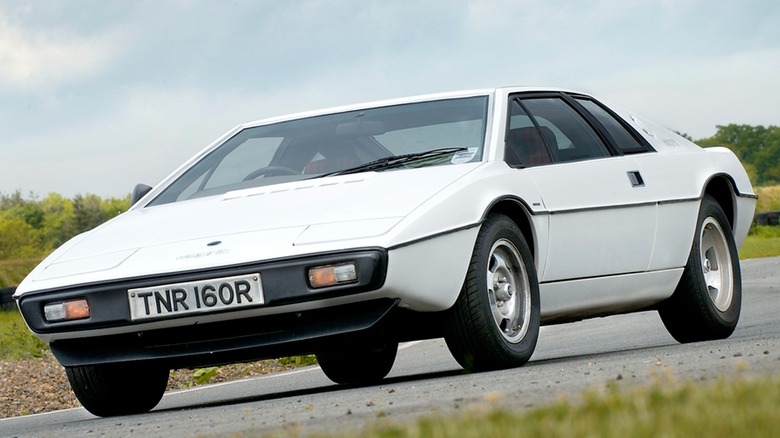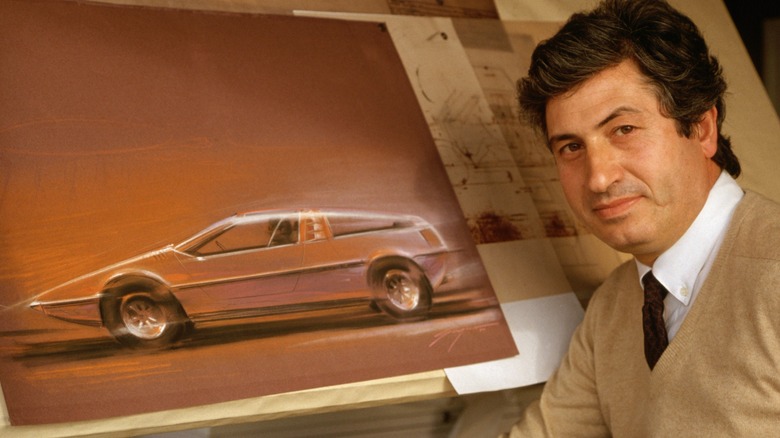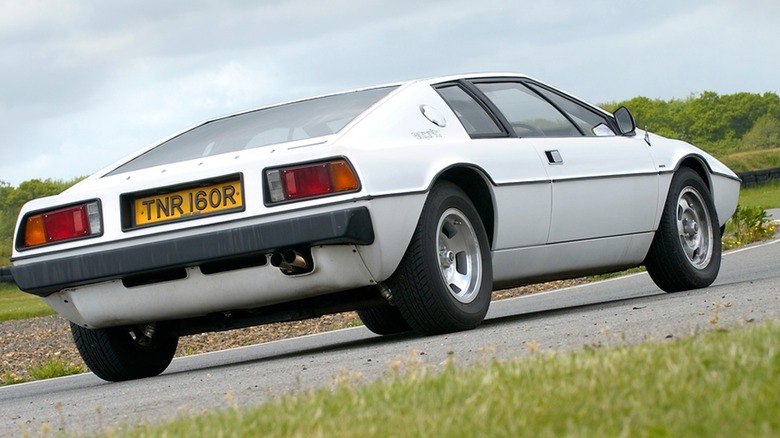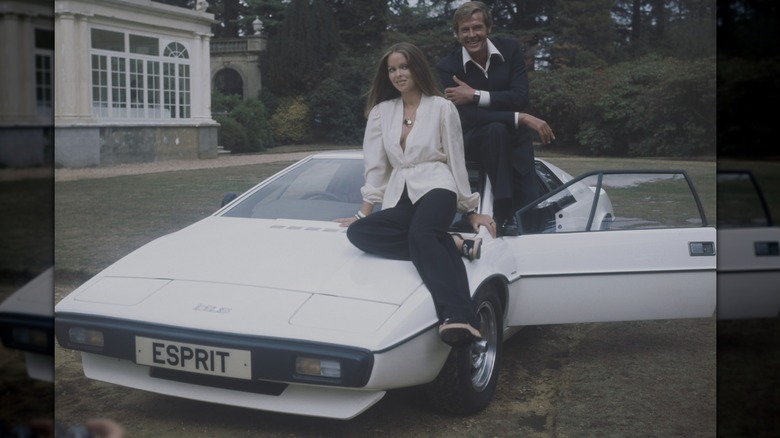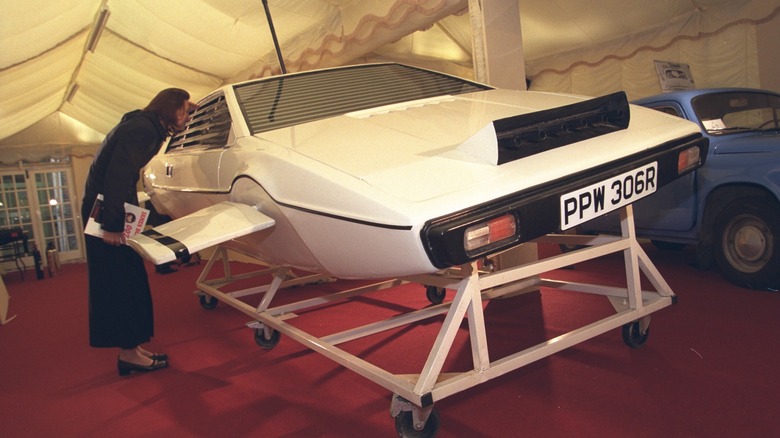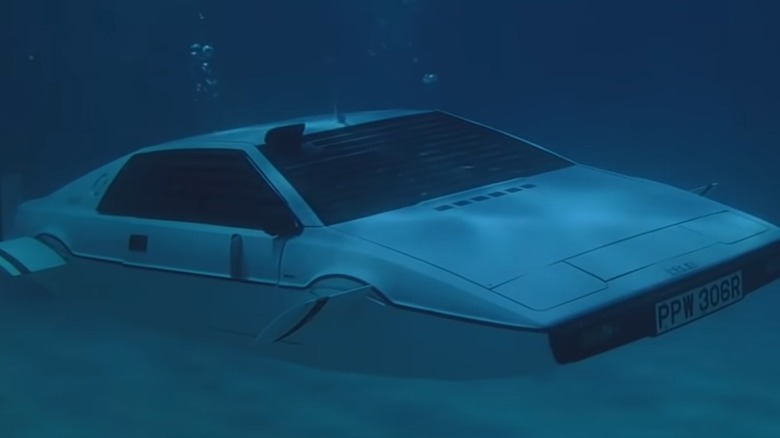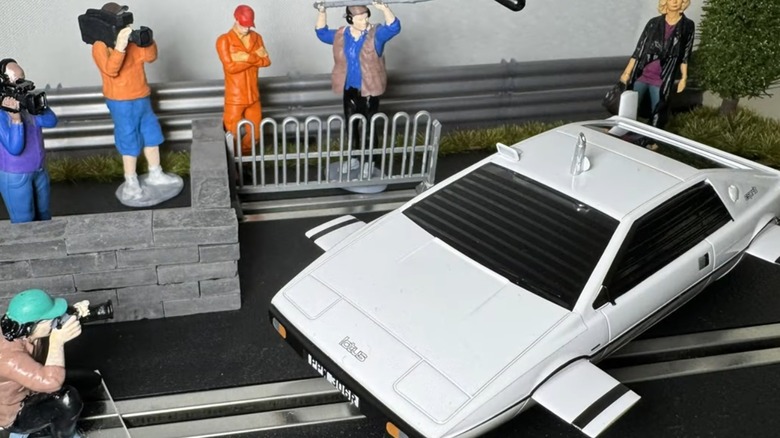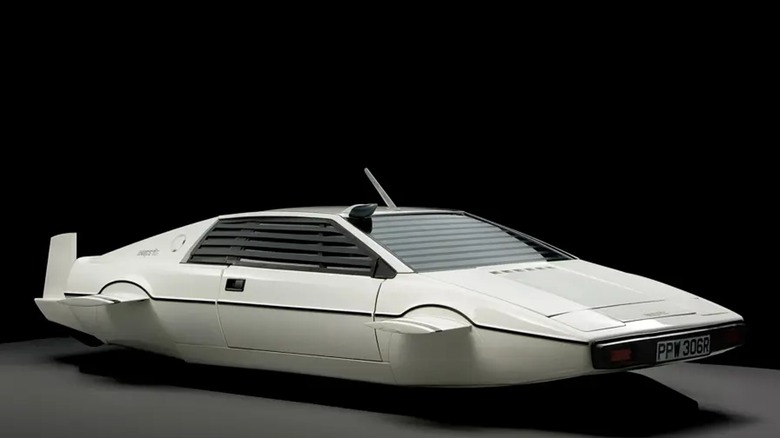8 Things You Never Knew About James Bond's Iconic 1976 Lotus Esprit Series I
Few movie franchises have the staying power and overall longevity of James Bond. The series is based on the novels of Ian Fleming about the exploits of a covert agent of the British Secret Intelligence Service, commonly referred to as MI6 — a service of the Crown responsible for protection of British interests overseas. With the 1962 release of the first Bond film, "Dr. No," the Cold War loomed large as the agent 007 navigated both adversaries from the Soviet Union as well as the criminal organization SPECTRE and often became entangled with the American CIA.
Aiding Bond in his missions is a variety of covert tools and weapons created by Q Branch. This includes everything from an attache case with a hidden firearm camera to a seemingly ordinary watch with built-in a geiger counter. But the most notable of all of Bond's special tools is his specially-equipped automobile.
While Sean Connery famously received a modified Aston Martin DB5 in "Goldfinger," his replacement, Roger Moore, first received from Q a slick 1976 Lotus Esprit featuring the most comprehensive and now iconic modifications of all Bond cars, submarine capabilities and on-board missile launchers. That model Esprit was also the debut year of what would become Lotus' most famous car for a generation, and these details about it you may not have ever known.
Drawn by a master designer
Starting with a job at Fiat in 1955, a young Giorgetto Giugiaro began a career designing cars, only to have his first design approved by Alfa Romeo a few years later after offering it to Nuccio Bertone. He then quickly proved his mettle as one of the pre-eminent Italian industrial designers and affixed the Giugiaro name to such masterpieces as the Maserati Ghibli, DeLorean DMC-12, and the BMW M1.
When Colin Chapman, founder of Lotus, sought to build a new car with aerodynamic properties to compete with the upper echelon of sports cars, he turned to Giugiaro. The first design of this car was presented at the Turin Auto Show in 1972 and showed strong influences from Giugiaro's work on the frenetic Maserati Boomerang concept of 1971. That car capitalized on the trend of wedge car design while the Esprit tamed it into something feasible for mass production, without sacrificing timeless qualities of beauty.
Stylistically, the Esprit is somewhat boring and devoid of sweeping lines and superfluous curves, yet it remains an iconic shape full of grace that is stunning no matter how many times you look at it. Furthermore, it worked — and raised Lotus' stature from sports car maker to be a genuine supercar competitor.
The Esprit's phenomenal staying power
The average car model will be on sale for eight years before a major redesign, including significant body and chassis changes, with most models having a mid-cycle refresh after four. Some models get stretched to a 10-year cycle or slightly longer but undergo several refreshes through that cycle. The Lotus Esprit is no average car model.
Debuting in 1975 for the 1976 model year, the Esprit immediately caught the eye of the automotive press and received many accolades for its sharp and attractive styling. A facelift Series 2 Esprit came only a few years later in 1978, arriving with a few exterior upgrades and better mechanicals followed by even more cosmetic changes again in 1981. While continuous improvements were made mechanically, the chassis and body remained largely the same until the 1988 model year, when Lotus performed a major refresh using a different designer to style the fiberglass body shell for the Series 3 car. Regardless, the Esprit shape remained in place but with more shapely and softer rounded edges.
The Series 3 Esprit remained in production largely unchanged on the outside until it ceased production in 2004, ending a 28-year run, interrupted by only two mid-cycle refreshes. Few cars, if any, last three decades without significant changes to the chassis and body. Even when Lotus made large styling changes, it was still unmistakably Esprit.
How Bond switched to Lotus
After having
driven a Bentley followed by two different Aston Martin models, James Bond got a Lotus Esprit
. Like his previous Astons, The Esprit was properly outfitted by Q to give agent 007 the means to escape a hairy situation. But why did Q modify a Lotus for the 1977 film "The Spy Who Loved Me?" The Lotus is a proper English-built car, but the reason has less to do with British patriotism and more to do with clever public relations work.
The integral part that Aston Martin played in the Bond franchise demonstsrated how powerful the association could be in raising publicity for a brand. A new Bond movie was in the works in 1976, and Lotus public relations manager Donovan McLauchlan caught wind of this and devised a clever stunt to get the new Lotus noticed by the producers. Pre-production was happening at Pinewood Studios, so McLauchlin took a pre-production Lotus Esprit with all branding covered up and parked it outside the main Pinewood building and left it — hoping to attract some attention from the producers.
McLauchlin returned some time later to a crowd that had gathered around the car, including some Bond producers. It's said that he returned to the car without engaging any of the onlookers, hopped in the car, and shot away without saying a word. This left the producers wanting to see more, eventually connecting with Lotus and hammering out a deal to put it in the movie.
The 007 Lotus special features
Thanks to Q Branch, the all-new Lotus model featured in "The Spy Who Loved Me" was outfitted to make a splash and endear the car to the public who saw the spy thriller in 1977. The splash happened literally thanks to extensive modifications converting the Esprit into a submarine, leading to one of the most memorable getaways in all of the Bond films.
To activate the submarine functions after entering the water, Bond merely has to flip a lever to start the transformation, pulling the wheels inboard and deploying stabilizer fins while quad rear propellers supply propulsion. The road gauges are replaced with submarine versions and a periscope gives spatial awareness. Finally, to ward off anyone continuing to search the waters, a surface-to-air missile launcher can destroy anything overhead.
Aside from being aquatic, the Esprit came packed with features for outwitting agents from either SPECTRE or the Soviet Union. Like the Aston DB5, oil slicks on demand could be sprayed on the pavement, but the Lotus also has a rear-mounted concrete sprayer to cover the windshield of those on the chase. Furthermore, the oil can be deployed underwater the way a squid uses ink. And for extreme security measures, its anti-theft system will self-destruct the car with explosives, which is what happens to a white Turbo Esprit in the next film, "For Your Eyes Only."
Submersible movie magic
If you watch the scene from the movie in which Bond drives into the water, it does look impressive, but anyone who knows a little about cars also knows these modifications are impossible to engineer. Therefore, the special effects people working on the movie employed some clever practical effects to pull it off.
Filming the underwater scenes required the use of both full-size and miniature Lotus submarine cars. In total, EON Productions received 11 cars for the movie and six body shells to use underwater. One car with no engine was shot by compressed air to enter the water at 60 mph. Hydraulic systems on full-size body shells performed the transformation into a submarine as it retracted the wheels, deployed the periscope, and moved the underwater panels in place.
One body shell was turned into a functional submarine by Perry Oceanographic in Florida. With battery-operated motors for the propellers and ballast tanks installed, the Lotus shell could be maneuvered underwater by divers with Scuba gear in the car. The louvers deployed to make it a submarine were more for obscuring the occupants during filming than making it watertight for 007. The scene ends with a drivable Lotus emerging onto the beach, which was towed by a cable on a hidden track in reality. The entire three-minute sequence took three months of pre-production and five weeks of filming to make.
James Bond Lotus legacy
The debut model Esprit from 1977 remains one of the most memorable in all of the franchise, but it never became such an integral part of the films in the way that Aston Martin did. From its first appearance in 1965 until today, six Aston models have appeared in 10 Bond films. Lotus was chosen for its Esprit for "The Spy Who Loved Me" and only appeared again in its follow-up, ""For Your Eyes Only."
Early in the second film, Bond drives a white Lotus Turbo Esprit casually down a winding road. He exits the car, careful to lock it up. While he is away, some guys approach the car, and although a large "burglar protected" sticker is clearly visible, one of them smashes the glass, only to be blown to bits as the car self-destructs. This leaves Bond driving a woefully underpowered Citroën 2CV in the major chase scene early in the movie.
Bond returns for an uneventful drive in a copper-colored Turbo Esprit later in the film. Roger Moore never drove an Aston Martin in his seven films as Bond, although he drove one in his cameo role in 1981's Cannonball Run. This was part of an effort to differentiate him from Sean Connery's depiction of the character and why Moore ended up driving a range of cars such as an AMC Hornet, Renault 11, and a Bajaj RE tuk-tuk in his other films.
007 Lotus Esprit in popular culture
While the Bond franchise has collectively made its mark on popular culture, many movies and even individual facets of movies have made lasting impressions. The Lotus Esprit is among them. And for having only a handful of minutes of total screen time, the impact is strong.
While finding figures to suggest the movies had any impact on Lotus car sales leads nowhere, it is hard to imagine they had no impact. But more significantly are the many ways that the white Lotus Esprit Series I continues to be celebrated today. Multiple companies including Hot Wheels, AUTOart, and Corgi have made it into toy cars of various sizes in both road and sea-going versions, some with retractable fins and launching missiles. You can also buy model kits of the car and slot car versions. Corgi also made 10 gold-plated submarine Esprits in 1977 for the premier, and the current value exceeds $2,000.
In addition to toy cars, people have made real Lotus Esprit models into James Bond tribute cars made to look exactly the same, including the correct interior colors and a range of buttons on the console along with a targeting screen for the missile launcher. Lotus even got in on this trend in 2016 by releasing 150 copies of the Evora Sport 410 with the same colors inside and out as the Bond Esprit in celebration of the 40th anniversary.
The real James Bond Lotus
During filming, many of the shells and even complete cars were damaged beyond repair as part of the creation of action scenes inherent to any Bond film. Perhaps other drivable cars have long been lost or squirreled away in sheds across England. However, one copy was hiding for years in a storage unit, only to be found after being put up for auction and discovered in 1989.
It turns out that the executive distributor for U.S. Lotus obtained the car after filming to use for a promotional tour. Afterwards, it was placed in a storage unit in Long Island with a 10-year lease pre-paid. At some point, the lease ran out and delinquent rent led to it being put up for auction in 1989 and sold for just $100. Despite having some damage to its roof, it was in complete and intact and received a full restoration, and surprisingly, was only occasionally exhibited.
Fast forward to 2013, and the screen-used submarine Lotus Esprit was put up for sale by Sotheby's auction house. It was presented in a pristine restored condition, although it was inoperable as this was the shell used for the moving underwater scenes. By the time the hammer came down, bids had risen to £616,000 ($997,000), with the final bid submitted by Tesla CEO Elon Musk. While he mentioned at the time plans to retrofit it with an electric Tesla powertrain, no news of the car appears to have surfaced since the sale.
